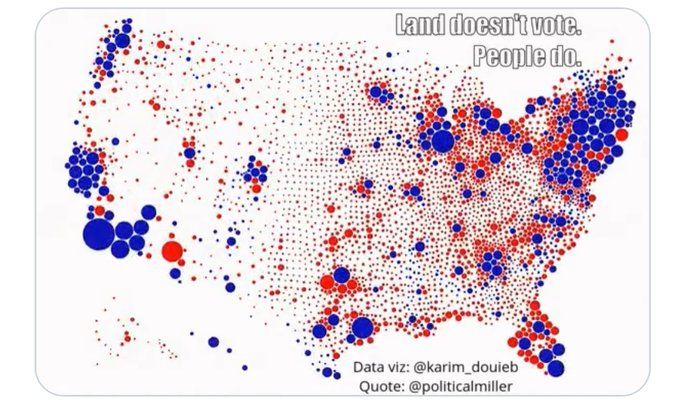The Right Kind of Hope (part 3½)
This is how we should respond to Trump's announcement that he's running for president again.
Hello! This was going to be the final part of the four–parter that began with parts ONE: We Are Losing and continued with (in one email) parts TWO: … Because of Structural Bias in Our Election System & THREE: To Start Winning We Need to Remove the Bias.
But let that come next time. Today I prefer to react to Donald Trump‘s long-time-coming advisory that he’s had it up to here with not being president anymore. Let’s call it …
THREE-AND-A-HALF: How We Need to Respond to the Announcement from Mar-a-Lago
It’s not 2015. We know things now that we may have doubted back then. We know that Donald Trump or someone like him can win the Republican nomination for president. We know that a person like that can go on to win the general election. We don’t know that one will, but we know one can. Seven years ago our ever-overconfident prognosticators told us these things couldn’t happen. Some are already saying it again. But we know.
And we know something about the kind of damage a person like that can do as president. We may prefer not to think about it—if, like me, you’ve already suppressed the details, try googling “worst stuff Trump did” for a vivid trip down memory lane—but we know.
We also know that if a far-right Republican does become president again in 2024, there’s a good chance it will be despite his rejection by the American people at the ballot box. That’s the story of 2016, and also of 2000—the only other time a non-incumbent Republican has won the presidency since the fall of the Berlin Wall. That year’s elevation of George W. Bush, the popular-vote loser, led to pointless suffering and death on an immense scale in a war in Iraq based on false pretenses, a critical abandonment of action on climate change, and many other irreparable disasters.
These past ravages of the Electoral College—these known risks for 2024—arrive unaccompanied by any countervailing benefit or justifying principle. While there are legitimate constraints on majoritarian power, including the protection of individual rights and the rights of vulnerable or unpopular groups, these legitimate constraints are not among those imposed by the Electoral College. On the contrary, the Electoral College curtails rights that the majority supports. Despite its geographic structure, the College doesn’t even protect the power of states or regions as such; it simply augments the power of states that right-wingers control at the expense of those they don’t.
So what to do about it? Specifics for how to get to popular election of the president will come in later emails. What can’t wait is changing our mentality. In service of that, here’s what I believe every Democrat and left-leaner should be saying in response to the rambling proclamation from the golf club:
Any right-wing extremist who wants to take up residence in the oval office will have to win a vote of the people of the United States of America first. If you think we’re signing on for another 2016–2020-style dystopia because that’s how the tally comes out based on the cockamamie counting rules concocted 235 years ago by a bunch of guys who also gave the thumbs up to slavery, think again. No way, not happening.
The candidate chosen by the people will be president.
This may sound outlandish, but what’s outlandish is to accept repeated subjugation to leaders chosen by a right-wing minority, with intolerable consequences that we fully understand. It may sound impossible, but the truth is that we are the majority, with both principle and power on our side. As soon as we recognize that, the illusion of impossibility will dissolve, replaced by the clarity of moral necessity, and we will get to work on the practical questions—not whether we can, but how we will.
Again, how we will is a topic for upcoming emails. In the meantime, consider talking to your friends and relatives over a piece of pumpkin pie about this—about our power, and therefore our responsibility. You can also forward this email to anyone who’d be interested. It’s even got a newsletter sign-up button in it right here:
Map of County Voting (Question from a Reader)
Before leaving you: A reader of this newsletter shared this nifty map and asked my thoughts on it:

She found it shortly after the election, posted to Twitter, which still exists as of this writing. If I’m not mistaken it’s from a set of maps by Karim Douieb based not on 2022 voting but on voting from the 2016 presidential election. It represents voting by county, each county blue or red for which party it went to and sized in proportion to their number of voters. It nicely depicts two points I made last time about our flawed election system: 1) Democrats are highly concentrated, Republicans relatively dispersed (thus there are more red circles, but the blue ones tend to be bigger), and 2) when you count places instead of people, you get a result that depends on how you chop up the map. A voting system based on counties, as this one shows, would be no fairer than the federal election system that’s actually in use—it would still be a vote of places—but it implicitly shows the arbitrariness of any place-based voting system.
The map that comes after this one on Douieb’s set of maps (link above) shows a modified version where each circle is divided into a blue part and a red part, sized in proportion to the party vote in the county. The total blue and red in that map, then, represents the total popular vote—a fair depiction of how we voted that simultaneously shows the geographic distribution.
Next time (probably):
FOUR: There’s a Way to Remove the Bias
Happy happy Thanksgiving! Write postcards for Warnock! Peace love gratitude.
Best,
David